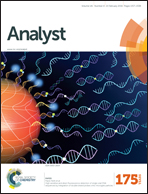UV-assisted Fenton digestion of rice for the determination of trace cadmium by hydride generation atomic fluorescence spectrometry
Abstract
A new digestion method using UV-assisted Fe0 Fenton reaction was developed for the determination of trace Cd in rice by hydride generation atomic fluorescence spectrometry. The proposed method integrated the advantages of simplicity, small dose of reagents, low cost and moderate reaction conditions, and was successfully utilized to analyze a Certified Reference Material (CRM) and real rice samples. A 1 mL mixture of the sample and reagents (0.0500 g rice powder, 0.2% (m/v) Fe0, 0.75% (v/v) HNO3 and 18% (v/v) H2O2) was irradiated by UV-light for 50 min and then a clear solution was obtained by separating excess Fe0 with a magnet prior to spectral analysis. The limit of detection (LOD) for Cd was found to be 0.02 mg kg−1 and the relative standard deviation was better than 5.0% at a concentration level of 0.40 mg kg−1. The recovery obtained by analyzing the CRM was 103% and spiked recoveries with 0.40 mg kg−1 Cd in rice samples were 93% and 101%. The t-test proved that there is no significant difference between the certified value and the determined value of the CRM, and between the proposed method and microwave-assisted digestion coupled with inductively coupled plasma mass spectrometry (MWD-ICP-MS) at 95% confidence level.


 Please wait while we load your content...
Please wait while we load your content...